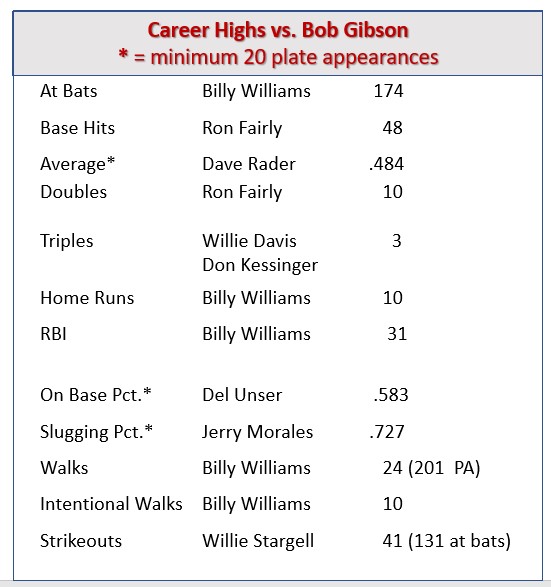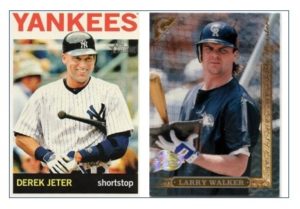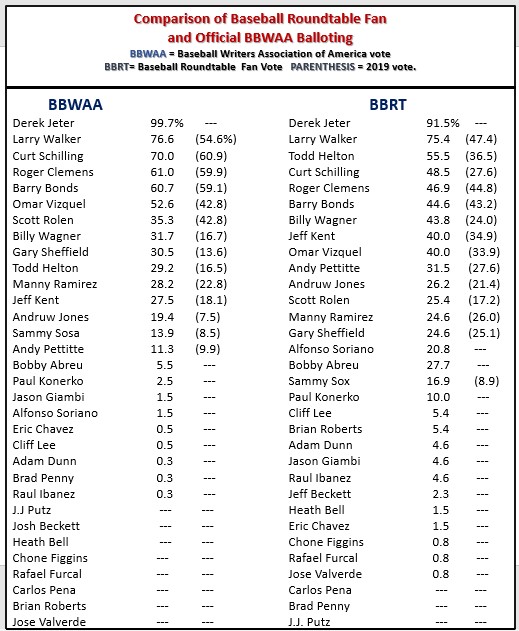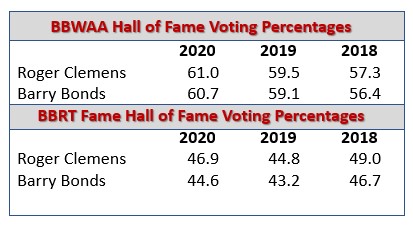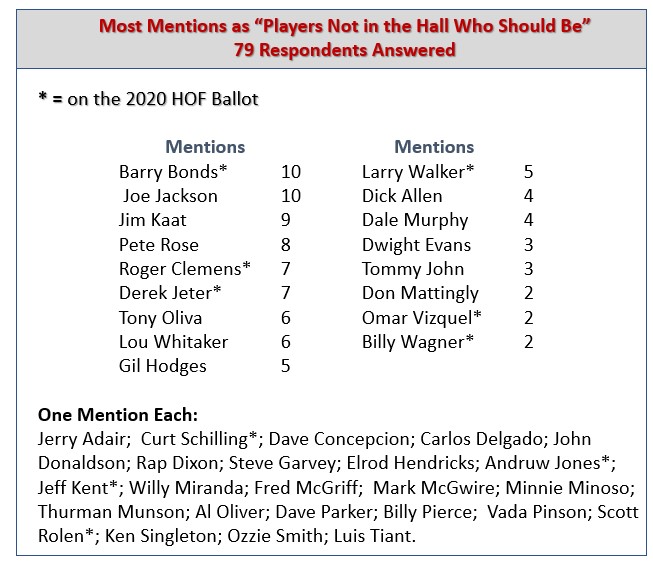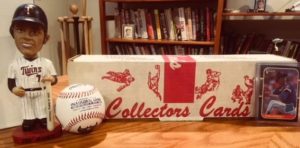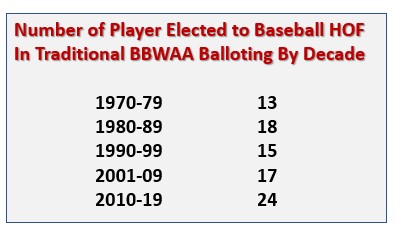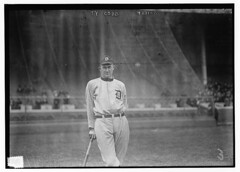WORKS BOTH WAYS
Nobody collected more career base hits off Bob Gibson than Ron Fairly (48) – and Fairly also collected more base hits off Gibson than he did against any other pitcher.
Who’s Your Daddy?
On September 24, 2004, in the middle of a tight pennant race, the Yankees handed future Hall of Famer Pedro Martinez and the Boston Red Sox a tough 6-4 loss. Martinez went 7 1/3 innings giving up nine hits and five earned runs. The game came just five days after (in his previous start) Martinez had lasted just five frames against the Bronx Bombers (eight hits, eight earned runs) in a 16-7 loss.
After that second loss, Martinez candidly commented, “What can I say? I just tip my hat and call the Yankees my daddy.” Little did he know that his comment – and a Yankee fans’ chant of “Who’s your daddy?” would follow him into future starts in New York (all the way to his final MLB start – against the Yankees for the Phillies – in Game Six of the 2009 World Series.)
The concept of “Who’s your daddy?” became the inspiration for Baseball Roundtable to take a look at the players who “had the number” of some of MLB’s premier pitchers. I started with Nolan Ryan (see that post by clicking here) and the topic was well enough received I decided to continue the journey. I followed up with Sandy Koufax. Click here for that one. And today, I’m taking a look at intimidating Hall of Fame righthander Bob Gibson. Note: I’ve since added Pedro Martinez, click here – and Randy Johnson, click here.
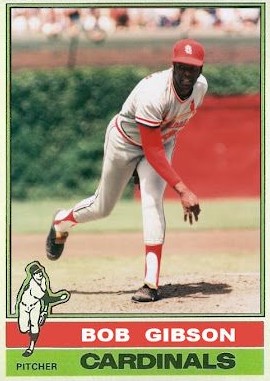 In 1968 … baseball’s Year of the Pitcher – Future Hall of Famer Bob Gibson went 22-9 and gave up just 49 runs in 304 2/3 innings (an MLB-low 1.12 earned run average), with batters hitting just .184 against him. He also logged a league-leading 268 strikeouts. Still, Billy Williams managed a .333 average and .412 on base percentage against Gibson that campaign – with a double, two home runs and four RBI – in four games. He went five-for-fifteen with two walks and just one whiff.
In 1968 … baseball’s Year of the Pitcher – Future Hall of Famer Bob Gibson went 22-9 and gave up just 49 runs in 304 2/3 innings (an MLB-low 1.12 earned run average), with batters hitting just .184 against him. He also logged a league-leading 268 strikeouts. Still, Billy Williams managed a .333 average and .412 on base percentage against Gibson that campaign – with a double, two home runs and four RBI – in four games. He went five-for-fifteen with two walks and just one whiff.
Over his 17-season MLB career (1959-75), Gibson went 251-174, with a 2.91 ERA and 3,117 strikeouts in 3,884 1/3 innings pitched. He was an All Star in eight seasons, a twenty-game winner five times, a two-time Cy Young Award winner, the 1968 NL Most Valuable Player and the MVP in the 1964 and 1967 World Series. In the 1968 World Series, Bob Gibson set the records for strikeouts in a World Series game (17) and strikeouts in a single World Series (27). In nine World Series starts (1964-67-68), Gibson went 7-2, 1.89 and tossed eight complete games.
Bob Gibson is the luckiest pitcher in the world. He is always pitching when the other team doesn’t score any runs.
Tim McCarver
So, let’s take a look at the “Who’s Bob Gibson’s Daddy?” lineup. (at least ten at bats versus Gibson). Here’s BBRT’s take on the players who fared the best against Gibson over his career.
Catcher – Dick Dietz (.389 average in 12 games versus Gibson)
The Giants’ Dick Dietz, who made his MLB debut in June of 1966 (and had just two seasons of 100+ games played … 1970-71), first faced Bob Gibson in the righthander’s spectacular 1968 season – and Dietz was not intimidated. In his first game against Gibson (May 28, 1968), Dietz went one-for-three and hit a game tying (1-1) solo home run in the sixth. (Gibson eventually got the win in a 3-1 Cardinals’ victory on a complete game four-hitter.) Dietz next faced Gibson on July 6 and delivered three walks and a single in four trips to the plate. In his 12 career games against Gibson, Dietz had a.511 on-base percentage, reaching base via hit or walk in all 12 games.
Dick Dietz played in eight MLB seasons (1966-73 … Giants, Dodgers, Braves), putting up a .261-66-301 line in 646 games. As noted earlier, he played more than 100 games in only two seasons, earning an All Star nod in 1971, when he hit .300, with 22 home runs, 107 RBI and 82 runs scored (all career highs).
——————————————————————————————-
First Base – Willie McCovey (seven home runs and 20 RBI in 46 games against Gibson)
Willie McCovey had a .290 average in 46 games against Gibson – with seven home runs (third most against Gibson) and 20 RBI (fifth most).
McCovey played 22 MLB seasons (1959-1980 … Giants, Padres, A’s), hitting .271, with 521 home runs and 1,555 RBI. The Hall of Famer was a six-time All Star, three-time league home run leader and the 1969 NL Most Valuable Player. Willie McCovey won the 1959 NL Rookie of the Year award despite playing only 52 games (called up by the Giants at the end of July). He hit .354 over those 52 games, with 13 home runs and 38 RBI.
4-for-4
In his very first MLB game, McCovey went four-for-four, with two singles and two triples, three runs scored and two RBI (all off future Hall of Famer Robin Roberts). He probably got some pretty good pitches to hit, batting between Willie Mays and Orlando Cepeda.
—————————————————————–
Second Base – Julio Gotay (.500 average vs. Gibson over three seasons)
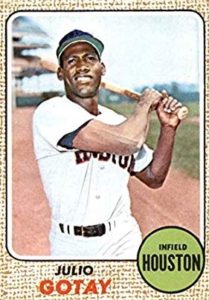 Astros’ 2B Julio Gotay – a bit of a surprise in this lineup – faced Gibson 17 times (16 at bats) between 1967 and 1969 (when Gibson went 55-29 with a 1.95 ERA) and collected eight hits (.500 average) and a walk.
Astros’ 2B Julio Gotay – a bit of a surprise in this lineup – faced Gibson 17 times (16 at bats) between 1967 and 1969 (when Gibson went 55-29 with a 1.95 ERA) and collected eight hits (.500 average) and a walk.
Gotay was a career .260 hitter (389 games over ten MLB seasons … Cardinals, Pirate, Angels, Astros) and his eight hits against Gibson were the most he had against any MLB pitcher (he also had eight against Bob Shaw). Gotay played more than 77 games in just one MLB season. As a Cardinal, in 1962, he played in 127 contests and hit .255, with two home runs and 27 RBI.
————————————————————————
A Mays’ Zing
Willie Mays faced Bob Gibson 108 times (92 at bats) over his career and hit just .196 against him – with three home runs, nine RBI, 16 walks and 30 strikeouts (in 33 games). In 1969, Mays faced Gibson five times and never got the ball out of the infield (four strikeouts, a foul pop up to the catcher and a grounder to short.)
—————————————————————-
Third Base – Richie Hebner (.387 average with power vs. Gibson)
In 20 games (over seven seasons), Richie Hebner went 24-for-62 against Gibson (.387 average). He also popped five home runs, drove in seven and drew ten walks (versus eight whiffs). Hebner reached base safety (via walk or hit) in 19 of his 20 games versus Gibson. Note: I also considered the Giants’ Dave Rader for this spot. In 31 at bats against Gibson, Rader collected 15 hits (a .484 average), but only one RBI. Hebner got the nod for doing more damage.
Hebner was a career .276 hitter (203 home runs/890 RBI) over 18 MLB seasons (Pirates, Mets, Tigers, Cubs). His best season was probably 1972, when he hit .300, with 19 home runs and 72 RBI for Pittsburgh. The most home runs he hit off any pitcher was five (against Gibson and fellow Hall of Famer Fergie Jenkins).
Hebner Going Deep
Richie Hebner worked as a (pick and shovel) gravedigger at his family-owned cemetery in the off-season.
————————————————————————-
Shortstop – Tie: Tim Foli (.483 average in nine games against Gibson) & Don Kessinger (44 hits and a career .326 average versus Gibson)
In nine games over three seasons, Tim Foli collected 14 hits and two walks in 32 plate appearances against Gibson (.483 average and .516 on-base percentage). Why does he only tie for this spot? He didn’t do much damage, just two extra-base hits (one double, one triple) and only two RBI.
Don Kessinger has to be mentioned here. While he didn’t top .400 versus Gibson (like Foli), Kessinger did more damage (eight RBI) and maintained a .326 average versus Gibson over 39 games (135 at bats). Kessinger had more than ten at bats against Gibson in seven seasons and hit .300 or better against him in five of those. His 44 hits against Gibson trail only Ron Fairly (48) and Billy Williams (45).
Tim Foli had a 16-season MLB career (1970-85), hitting .251, with 25 home runs and 501 RBI (1,696 games … Expos, Mets, Pirates, Angels, Giants, Yankees).
Kessinger also played 16 MLB seasons (Cubs, Cardinals, White Sox), hitting .252, with 14 home runs, 899 runs scored, 527 RBI and 100 stolen bases. He was a six-time All Star and two-time Gold Glover.
All American Boy
Don Kessinger was an All American in both baseball and basketball for the University of Mississippi.
—————————————————————————
Outfield – Billy Williams (10 home runs in 52 games vs. Gibson)
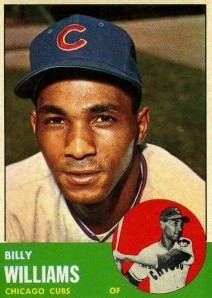 Nobody took Bob Gibson deep more often than the Cubs’ Billy Williams – who topped the list of home runs off Gibson with ten and RBI with 31. (It was also the most home runs and RBI Williams had against any pitcher.) How much respect did the big righthander show Williams? Williams also drew the most career walks (24) and career intentional passes (10) from Gibson (although surprisingly he was never hit by a Gibson pitch). (Side note: Williams’ 201 plate appearances were also the most he had against any hurler.)
Nobody took Bob Gibson deep more often than the Cubs’ Billy Williams – who topped the list of home runs off Gibson with ten and RBI with 31. (It was also the most home runs and RBI Williams had against any pitcher.) How much respect did the big righthander show Williams? Williams also drew the most career walks (24) and career intentional passes (10) from Gibson (although surprisingly he was never hit by a Gibson pitch). (Side note: Williams’ 201 plate appearances were also the most he had against any hurler.)
Taking One For The Team
Although Gibson was known for pitching inside, he only hit 102 batters in his career and never led his league in hit batsmen (although he did finish in the NL’s top five in HBP six times). Ironically, the two batters he hit most often in his career (six times each) were Ron Hunt and Roy McMillan (who hit .176 and .194 against Gibson, respectively.)
Hall of Famer Billy Williams had an 18-season MLB career (1959-1974 with the Cubs and 1975-76 with the A’s). The six-time All Star hit .290 (2,711 hits), with 426 home runs and 1,475 RBI. He was the 1961 NL Rookie of the Year and the 1972 NL Batting Champ.
—————————————————————
Outfield – Ron Fairly (48 hits and a .302 average over 52 games against Gibson)
As noted at the top of this post, Ron Fairly’s 48 hits against Gibson are the most of any batter and his 24 RBI off Gibson trail only Billy Williams (31) and Hank Aaron (26). In addition, Fairly drew 17 walks (versus 14 strikeouts) off Gibson.
Ron Fairly played 21 MLB seasons (1958-1978 … Dodgers, Expos, Cardinals, A’s, Blue Jays, Angels). He had a .266 career average (1,913 hits in 2,442 games), with 215 home runs and 1,044 RBI. He made his first All Star team in his 16th MLB season (1973), when he hit .298-17-49 for the Expos. He made his second and final All Star squad in 1977 – this time for the American League Toronto Blue Jays. That season (his 20th MLB campaign), the 38-year-old hit .279, with a career high 19 home runs.
Ron Fairly’s best season against Bob Gibson came in 1971, when he faced Gibson 11 times and collected five hits (including one double and one home run) and two walks (.714 average and .727 one-base percentage).
——————————————————
Outfield – Al Oliver (.342 average in 20 games)
Al Oliver put the ball in play against Gibson. In 78 plate appearances he fanned just three times, walked once and was hit by a pitch twice. He collected 25 hits off Gibson (.342 average), with three doubles, one triple, four home runs and 14 RBI – and he didn’t collect his first hit off Gibson until his seventh at bat.
Oliver played 18 MLB seasons (Pirates, Rangers, Expos, Giants, Phillies, Dodgers, Blue Jays) and hit .303, with 2,743 hits, 219 home runs and 1,326 RBI. Oliver hit .300 or better in 12 seasons. He was a seven-time All Star and won the 1982 NL batting title with a .331 average. He led his league in hits once, doubles twice and RBI once.
————————————————————
Honorable Mention – Willie Davis
Willie Davis deserves an honorable mention here. In 39 games against Gibson, he hit .320 (40-for-125), with five doubles, three triples, four home runs and 21 RBI. In a game on August 17, 1970, the Dodger outfielder touched Gibson for two triples and a single in five at bats – as his Dodgers lost to the Cardinals 11-8. (Gibson got the win despite giving up 14 hits and eight earned runs in 8 1/3 innings. )
Davis had a 18-season MLB career, primarily with the Dodgers, hitting ..279 (2,561 hits), with 182 home runs, 1,053 RBI and 398 steals. He was a two-time All Star and two-time Gold Glover (who, ironically, set a World Series record by committing three errors in a single inning – fifth inning, Game Two, 1966 WS). The 1966 WS was a rough one for Davis, he also went just one-for-sixteen (.063 average) as the Dodgers lost four straight to the Orioles scoring just one run.
A trivia question you can use. In the 1966 World Series the Dodgers scored just two runs against a tough Orioles’ pitching staff. Those runs came in the second and third innings of Game One – on a solo home run and a bases-loaded walk. Which pair of “Jims” collected the Dodgers’ two RBI? Jim Lefebvre on a solo home run leading off the second inning and Jim Gilliam on a bases-loaded free pass in the second.
Bonus: Who were the three Orioles’ starting pitchers in the Series? Dave McNally, Jim Palmer and Wally Bunker. The Orioles used one reliever in the Series – Moe Drabowsky, who threw 6 2/3 scoreless frames to get the win in Game One. Games 2-3-4 were complete game shutouts by Bunker, Palmer and McNally (who started Game One).
Del Unser Had a Knack for Getting On
Outfielder Del Unser may have only been a career (1968-1982) .258 hitter (.319 on-base percentage), but he deserves notice for his work against Bob Gibson. In seven career games against Gibson, Under came to the plate 24 times and collected six hits and eight walks (versus just two whiffs) for a .375 average and .583 on base percentage.
——————————————————
Pitcher – Bill Henry (Gibson never got him out)
One note here. I waived the 10-at bat minimum for pitchers hitting against Gibson – which opened the door for the Reds’ Reliever Bill Henry, who faced Gibson in only one game (September 19, 1964) and went two-for-two, with a pair of singles.
Bill Henry had a 16-season MLB career (primarily as a reliever). He pitched in the majors from 1952 through 1955 and 1958 through 1969 (Reds, Giants, Red Sox, Cubs, Pirates, Astros.) As a batter he hit .177 (36-for 203) and Gibson was one of only five pitchers that Henry collected more than one hit off of.) On the mound, Henry was 46-50, 3.26 with 90 saves in 527 appearances.
____________________________________________
A few more honorable mentions: The following players not in this lineup hit .350+ for their careers against Gibson: Denny Doyle (.464-1-3 in 28 at bats); Rico Carty (.389-0-10/54 at bats); Ralph Garr (.387-0-1/12 at bats); Dave Cash (.375-0-9/56 at bats); Don Hoak (.375-1-4/24 at bats); Willie Crawford (.370-2-5/46 at bats); Jerry Morales (.364-2-4/22 at bats); Don Blasingame (.357-0-5/28 at bats); Felix Milan (.355-0-9/76 at bats); Joe Adcock (.351-3-7 in 37 at bats).
A few other tidbits:
- Hank Aaron hit only .215 against Gibson (but did knock eight home runs and pick up 26 RBI in 163 at bats);
- Willie Stargell fanned more times against Gibson than any other player (41 whiffs in 131 at bats), but still hit .290-5-15 against him;
- Bill Mazeroski only fanned six times in 99 at bats against Gibson, but collected just 14 hits (.141 average), with one home run and four RBI.
- Darrell Evans had the most plate appearances and at bats (35 and 23) against Gibson without ever striking out, while hitting .261-3-5 with 11 walks.
Primary Resource: Baseball-Reference.com
Still thinking about this year’s Baseball Hall of Fame voting? To see how Baseball Roundtable’s fan vote compared to the BBWAA official voting, click here.
 Baseball Roundtable is on the Feedspot list of the Top 100 Baseball Blogs. To see the full list, click here.
Baseball Roundtable is on the Feedspot list of the Top 100 Baseball Blogs. To see the full list, click here.
I tweet (on X)baseball @DavidBaseballRT
Follow/Like Baseball Roundtable’s Facebook Page here. More baseball commentary; blog post notifications; PRIZES.
Member: Society for American Baseball Research (SABR); The Baseball Reliquary; The Negro Leagues Baseball Museum.
